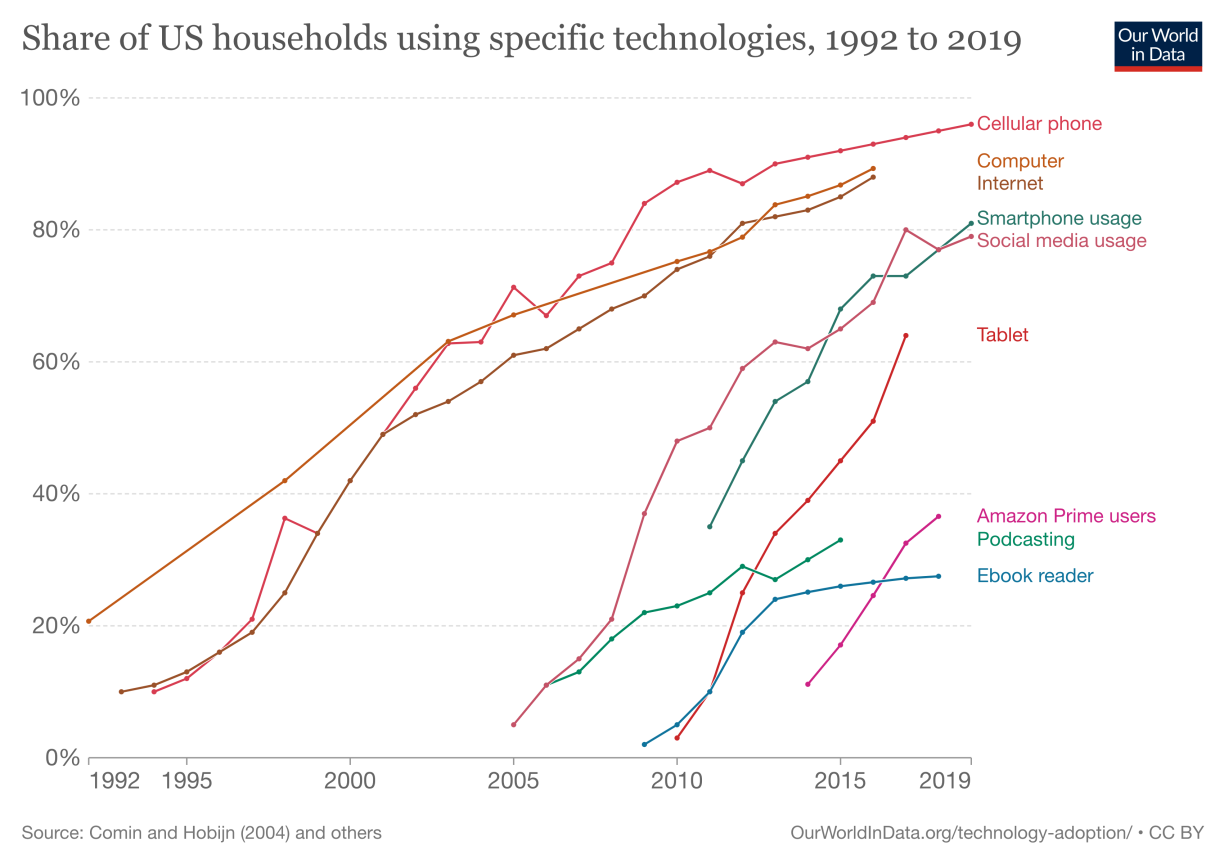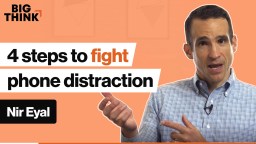What is technology addiction? (And how you can better manage it)

- Technology addiction may be a new form of behavioral addiction.
- But research has yet to define the contours of this disorder.
- We can self-examine whether using digital devices advances or distracts us from our lives.
Signs of technology addiction seem to be everywhere. Research shows that we check our phones more than 100 times a day. Stories of people who want to quit social media but can’t are plentiful. Our devices distract us from our work and downtime. It’s gotten to the point that we download apps to monitor our smartphone intake, like some bartender eyeing the tab to head off overservice.
At the same time, it’s undeniable that digital technologies have made our lives better. They allow us to work more efficiently, provide instant access to a wealth of knowledge, and keep us connected to friends and loved ones the world over.
Can we enjoy these benefits while avoiding the darker side of these new technologies? Maybe, but that requires us to better understand what technology addiction is and be honest about our relationship with these devices.

A new form of addiction?
It’s difficult to determine the magnitude of technology addiction because there’s no consensus as to what it entails. The very idea that technology can evoke a dependence in the vein of alcohol or heroin is novel — though every new technology has cultivated its share of alarm and scrutiny, even the printing press and crossword puzzles.
As such, there’s an ongoing debate among professional psychiatrists and psychologists as to whether technology addiction should be classified as an addictive disorder or compulsive behavior.
The American Psychiatric Association added gambling disorder to the most recent edition of the Diagnostic and Statistical Manual of Mental Disorders (DSM-5). The first behavioral addiction to be included, gambling disorder was found to be “similar to substance-related disorders in clinical expression, brain origin, comorbidity, [function], and treatment.”
The association also introduced internet gaming disorder in the research appendix, claiming insufficient evidence as to whether the condition is a unique mental disorder and recommending further exploration.“ However, Internet gaming may represent just one facet of problematic use of the Internet,” wrote Marc Potenza, a psychiatrist at the Yale School of Medicine, in Addictive Behaviors, “and the potential impact of other Internet-related behaviors (e.g., social networking, shopping, pornography viewing, gambling) warrants consideration.”
Does digital technology cause addiction?
That research is underway. In his book Irresistible, Adam Alter, a professor of marketing at the New York Stern School of Business, cites a 2011 review by psychology professor Mark Griffith showing that 41% of a large sample suffered from at least one behavioral addiction in a given year.
Looking at technology specifically, Alter found a survey suggesting that “up to 40 percent of the population suffers from some form of Internet-based addiction, whether to email, gaming, or porn” and another suggesting that “48 percent of its sample of U.S. university students were ‘Internet addicts,’ and another 40 percent were borderline or potential addicts.”
Now, these numbers should be read with a prominent asterisk. Except for gambling disorders, there is no clear consensus as to what qualifies as a behavior addiction. As such, these studies must rely on their own definitions. For example, Griffith defines it as the “loss of ability to choose freely whether to stop or continue the behavior (loss of control) and [the] experience of behavior-related adverse consequences.”
A lot also depends on the methodology used and the population being studied. While the research cited by Alter shows high percentages of internet addicts or borderline addicts, other studies and systematic reviews have found internet addiction to be far less prevalent — as low as, if not lower, than 20%.
Consensus around such issues takes time, and in the case of technology addiction, we’re just getting started.
Even so, those numbers may ultimately represent many people struggling with compulsive technology use — or, at the very least, are having trouble setting healthy boundaries. And the consequences for them can look painfully similar to substance abuse.
Per Griffith’s research, technology addiction can interfere with work and social activities. It may damage relationships and produce harmful feelings such as anxiety, depression, and emptiness. It can even lead to injury, legal problems, and financial loss.
I think the skill over the next number of years into decades will be learning how to manage our relationship with tech in a sustainable way.
Adam Alter
Technology addiction: A self-assessment
If you have concerns about your own technology use, Alter has a three-question self-assessment to help you determine if you have a problem. They are:
Can I reach my device without moving my feet right now?
If the answer is “yes” 24 hours a day, Alter says, then you may have a problem. He recommends trying to spend more time away from your device. See how it feels to not have your screens constantly encroaching on your existence. Do you feel lighter or agitated?He also recommends putting your screens away 90 minutes before bed. The light they emit disrupts your circadian rhythm and creates costly sleeping habits. (Yes, even with night mode on.)
Am I constantly immersed in time-bound environments?
That is, do your activities and relationships sometimes take you to places free of technology’s influence? Or is it a persistent presence?If the latter, Alter recommends going for a walk in the woods, visiting the ocean, or chatting with friends in a cafe without a phone perched on the table. Research suggests that face-to-face interactions help us form more positive impressions of others. Meanwhile, an increasing number of studies are demonstrating the value nature has on our health and mental well-being.
Is my relationship with tech harming my well-being?
This question branches out into a myriad of others. These include how technology affects you emotionally, how much money you spend on it, whether it aids or hinders your work, how it affects your relationships with others, and whether your screen time interferes with salutary pursuits like exercise or skill development.
You should explore all of these questions to look for areas where technology may be interfering with, rather than supporting, your life.
Steps toward a better relationship with technology
As with any self-assessment, there are caveats to be aware of. Alter points out that there’s a distinction between an addiction and simply using technology a lot. For many, work alone demands hours at the keyboard or with a tablet in hand. And after a long day, who would begrudge you a mindless hour with a favorite sitcom or video game?
Nor is answering yes to any of these questions proof of a disorder. It could simply indicate an area of your life in need of adjustment (especially in the case of behavioral addictions where there’s much we need to learn).
“These are all questions that are easy to answer, and they are subjective,” Alter said. “[But] if you feel that there’s a problem there, then you probably need to do something about it.”
That first step is admitting the trouble and challenge.
The next is seeking help. Depending on the severity, that may mean talking with a trusted friend or loved one and devising a plan of action. It may also mean finding a psychiatrist or psychologist who specializes in this area.
A professional can help you develop the tools and practices needed to adjust the problematic behavior. They may also be able to diagnose any underlying conditions that are feeding such behavior, such as depression or anxiety.
“I think the skill over the next number of years into decades will be learning how to manage our relationship with tech in a sustainable way,” Alter said. “The people who do that best, I think, will be the most successful people and the happiest people.”
Learn more on Big Think+
With a diverse library of lessons from the world’s biggest thinkers, Big Think+ helps businesses get smarter, faster. To access Adam Alter’s full class for your organization, request a demo.





